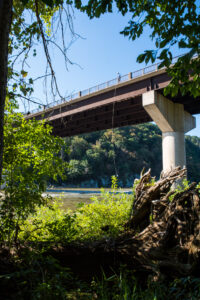The ICPRB staff has researched algae blooms in the basin for many years. Most of this work has focused on chronic blooms of filamentous algae in the Shenandoah and Cacapon rivers in Virginia and West Virginia. While algae is an essential part of any natural waterway, chronic blooms, where algae forms large mats before decomposing restrict recreational use of stream and rivers and can compromise water quality and damage other aquatic life.
Another type of algae, known as blue-green alga or cyanobacteria can under some conditions produce a toxin that can be harmful to human and pets that ingest the water as well as aquatic life. The upper Potomac basin also has chronic blooms of blue-green algae that seem to be growing over time, most recently on the Shenandoah River, where the Virginia Department of Health issued a Harmful Algae Bloom (HAB) Advisory for a 53-mile stretch of the North Fork of the Shenandoah River on August 10, 2021. The ICPRB was preparing to survey the bloom area with other organizations when Tropical Storm Ida brought torrential rains to the basin that scoured the algae blooms from the river. The ICPRB then ran its Emergency River Spill Model to attempt to track the algae and its toxins downriver. The model estimated the time it would take for the algae and its toxins to reach the Potomac mainstem. The extreme flow conditions and high dilution factors resulted in no detection of cyanobacteria, according to a recent ICPRB Report on the Rapid Response Survey.
The ICPRB is enhancing the spill model with sensing data collected by air and on the river that increases understanding of the river’s hydraulics during different flows and increasing tracking accuracy for algae or spills of oil or other toxics that can compromise river ecology and drinking water supplies.

